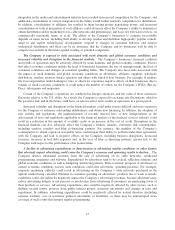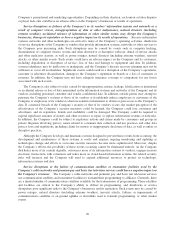Time Magazine 2013 Annual Report Download - page 32
Download and view the complete annual report
Please find page 32 of the 2013 Time Magazine annual report below. You can navigate through the pages in the report by either clicking on the pages listed below, or by using the keyword search tool below to find specific information within the annual report.The inability of the Company to acquire or produce popular programming on acceptable terms could
adversely affect its operating results. The Company obtains a significant portion of the programming for its
cable networks, such as motion pictures, television series and sports events, from movie studios, television
production companies and sports organizations. The Company has agreements with certain movie studios that
provide its premium pay television services with exclusive rights to exhibit the studios’ original feature films
during specified time periods. Competition for popular programming is intense, and the growing number of
SVOD services has increased the competition for programming both in the U.S. and internationally. The
Company may have to increase the price it is willing to pay to avoid being outbid by its competitors for the rights
to programming or in connection with the renewal of programming it currently licenses, and the cost to license
such programming may increase due to such competition. The cost may also increase as the Company and other
companies seek the right to exhibit programming exclusively during the applicable license period or on new
distribution platforms. The Company also produces programming and it incurs costs for creative talent, including
directors, actors, writers and producers, as well as costs relating to development and marketing. The increased
amount of original programming being aired by basic cable networks and premium pay and basic tier television
services and, to a lesser extent, SVOD services could increase costs for talent due to increased competition for
their services. The Company also incurs significant newsgathering costs at its cable news networks.
The loss of subscribers could adversely affect the Company’s results of operations and future revenue
growth. If video service rates charged by affiliates continue to increase or economic conditions worsen,
subscribers may cancel their multichannel video service subscriptions, reduce the number of services they
subscribe to or elect to subscribe to a lower-priced tier or offering that may not include all of the Company’s
cable networks or premium pay or basic tier television services. In addition, technological developments and
changes in consumer behavior, particularly among younger consumers, could result in such consumers choosing
not to subscribe to multichannel video services. The Company’s cable networks and premium pay and basic tier
television services also face increasing competition from SVOD services. If consumers elect to utilize these
services as an alternative to multichannel video services provided by affiliates, the Company’s cable networks
and premium pay and basic tier television services may experience a lack of growth or declines in subscribers. In
addition, if affiliates reduce their marketing efforts associated with the Company’s premium pay or basic tier
television services or choose to promote their own movie and television programming or on-demand offerings in
lieu of the Company’s premium pay or basic tier television services, the number of subscribers to such networks
and services, respectively, could decline. In addition, the loss of carriage on the most widely distributed
programming tiers, including as a result of an affiliate’s creation of lower-priced video packages or tiers or
genre-based packages that do not include the Company’s cable networks or premium pay or basic tier television
services, could reduce the distribution of the Company’s programming. A decrease in the number of an affiliate’s
subscribers or the number of subscribers to the Company’s cable networks, domestic premium pay television
services or international premium pay and basic tier television services could result in a decrease in the
Company’s subscription and advertising revenues.
Sales of DVDs have been declining, which may adversely affect the Company’s results of operations.
Several factors are contributing to an industry-wide decline in DVD sales both domestically and internationally,
which has had an adverse effect on the Company’s results of operations. These factors include consumers
shifting to subscription rental services and discount rental kiosks, which generate significantly less profit per
transaction for the Company than physical disc sales; changing retailer strategies and initiatives (e.g., reduction
in floor space devoted to Blu-ray Discs and DVDs); retail store closures; the general economic downturn in the
U.S. and many regions around the world; increasing competition for consumer discretionary time and spending;
and piracy. The Company’s efforts to offset the decline in DVD sales and its efforts to make digital ownership of
films more compelling to consumers (e.g., Blu-ray Disc sales, EST and establishing later rental windows) may
not be successful or it may be several years before consumers accept these offerings.
The Company’s businesses operate in highly competitive industries, and the failure to compete
successfully may have an adverse effect on the Company’s businesses or results of operations. The
Company’s businesses face intense competition in the U.S. and other countries from many different sources,
including numerous direct competitors and other media, including pirated content. Consolidation and vertical
16
























